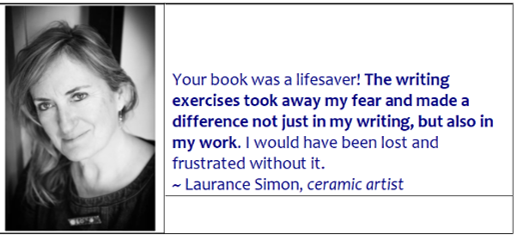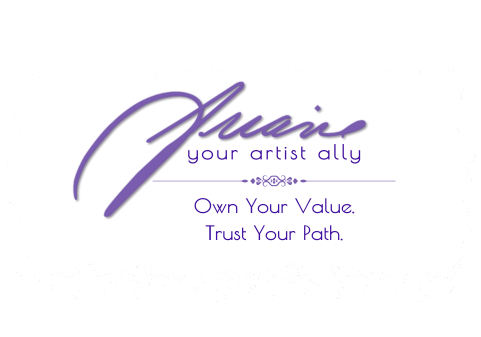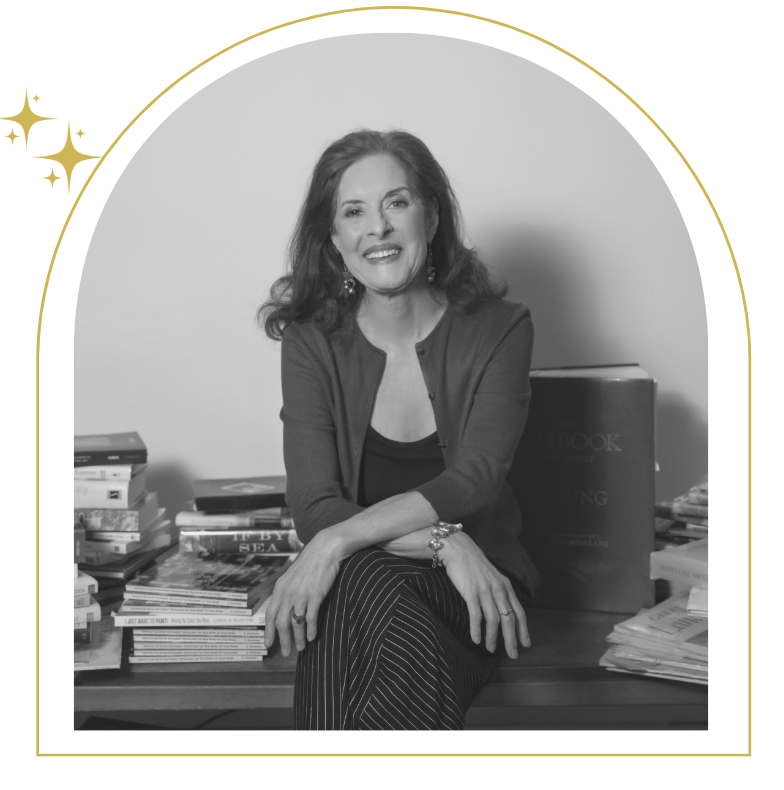First, let’s recap the first four mistakes from 7 Avoidable Artist Statement Mistakes: Part 1.
Artist Statement Mistake No. 1 Giving Up The Words Around Your Art
When people buy art, they are subconsciously (or consciously) also buying access to the artist who, by virtue of the work they do, is bestowed with a creative aura. Combining word-language with the artist’s visual language creates a sticky factor in the viewer’s mind that serves any artist well.
Artist Statement Mistake #2: Thinking You Have To Explain Your Art
People viewing art don’t need an explanation, they need connection. They want to be touched by the artist as they’ve been touched by the artist’s work.
Artist Statement Mistake #3: Using The Third Person
First person is both honest and relatable. Third person is holding your reader at arms-length, and this creates distance instead of the closeness to you that your viewer is craving.
Artist Statement Mistake #4: Waiting Until The Last Minute
An effective, compelling artist statement takes time because you want the same authenticity and uniqueness to shine through that shines in your work. Also, since artist statements are often used in other venues, a looming deadline might cause you to cut corners that will make the difference between an acceptance or rejection.
And now…let’s roll right into the seriously avoidable artist statement mistakes No.5, No.6 & No.7.

Artist Statement Mistake #5
Ignoring the power of an artist statement presentation
I remember going to an open gallery event where the artist had photocopied her statement on a single 8/11.5 sheet of paper, printed out a stack as high as a glass of water, and left it on a table at the front of her studio.
I stayed for about 45 minutes, and in that time, with a roomful of people, I saw exactly one person, stop, pick up the first copy, glance at it, then put it back on top of the stack.
No one left with her artist statement. No one even read her artist statement.
Is this a comment about the fruitlessness of artist statements? Or its fruitless presentation…
Compare this to two other artist exhibits I attended:
The first was a sculptor who wrote an artist statement for each piece he displayed.
He printed these on gorgeous paper, with a font large enough to easily read over another person’s shoulder. He displayed these at an average eye-height, for a person standing, and threaded the page through a thin metal post at the top, held in place by a metal base at the bottom.
Was this extra work? You bet! But the result was two-fold.
- Everyone who stepped up to any one of his sculptures, first glanced at the artwork, then turned to read the statement next to it, then turned back to take a second, longer look at the piece. If they had a companion, a conversation ignited.
- The exhibition sold out on opening night!
The second was a photographer who wrote a stunning statement, then blew it up to a taller-than-a-person, vertical board, an easy to read font with an attractive, but subtle frame. It was impossible to ignore. Everyone stopped to read it, then continued to look at the collection with her statement humming in the background of their minds.
When our brains are lit up by more than one form of compelling communication, in this case visual + linguistic, the layered content becomes impossible to forget. It’s what I call the ultimate sticky effect.
While this may be the last thing you want on your list before an exhibition, your presentation style sends out subliminal messages about you and your work.
You don’t leave your artwork in a heap, or crammed together, or placed without thought on the wall because you understand that the way you present your work becomes a reflection on the work itself.
Your artist statement—though smaller, percentage wise, then the sum total of your artwork—deserves the same careful attention to presentation detail you give your artwork, because it reaps the same rewards.
When you scorn presentation details because you think these are not important or essential, you drop a valuable opportunity to establish your influence on the overall impact for how your work is viewed.
Because all of us are shell-shocked from commercial, aesthetic bombardment, your viewers need all the help you can give them to appreciate, and remember, what you do.
Each presentation detail builds a cumulative aura, a signature of style, which lingers around your work, whether you want it to or not.
Disregarding details, and hoping their absence gets you off the hook, does not work.
Absences, like silences, carry their own message, a message that is much more difficult to influence and direct than the details you tried to avoid.

Artist Statement Mistake #6
Thinking your artist statement is about marketing your work
I’ve said this before, and I’ll say it again: marketing strategies, by their very nature, are designed to be manipulative, while the power of an artist statement lies in the authenticity of its authorship.
When you define an artist statement as a marketing ploy, it effectively undermines the sincerity needed for a convincing, compelling statement.
We humans instinctively know when something is done with care or not. There is a resonance of the cared for that is unmistakable. We may not be able to say exactly why, or what, we are responding to, but when something is done with respect to authenticity and the spirit, respond we do.
And, yes, after you’ve written you artist statement, then you can consider how to use it in your marketing.
As I’ve written in my book, Chapter 3: Soul, Not For Sale: “The point of an artist statement is to be in service to your art, not the marketplace.”

Artist Statement Mistake #7:
Forgetting the real reason you need to write your AS
Because it helps you expand the range of your connection with a potential buyer. More connections, the stickier your art becomes. The stickier your art becomes, the longer they remember you.
The longer they remember you, the greater chances to sell your art. The equation is so obvious, I find it hard to understand why an artist doesn’t jump at the chance to own this space.
Consider this one sentence from Words Can Change Your Brain by the neuroscientist Dr. Newberg and researcher Waldman. “A single word has the power to influence the expression of genes that regulate physical and emotional stress.”
If you are an artist who feels resistance at writing an artist statement, remember this: no one tell your artist story better than you.

P.S. If you want the best crash course in writing (or updating!) your artist statement, I wrote Writing the Artist Statement: Revealing the True Spirit of Your Work to give everyone, who finds writing about themselves a chore, a simple system.
I guide you through my writing process, one easy chapter at a time.
Write your statement once, and you’ll have a system in place forever.









